Learn Muscle Anatomy: Muscles of Mastication
Posted on 3/19/14 by Courtney Smith
You know what I really enjoy? Eating.
Not just food itself, but the actual act of chewing something. Gum, steak tips, cake, one of those ginormous blueberry muffins from Dunkin Donuts up the street—anything, really. I love working the muscles in my jaw in the act of mastication, or to reduce something to a pulp by crushing or kneading it with my teeth. There's something immensely satisfying about it.
Whenever you see a description of chewing or eating, it's always the jaw that's mentioned. While the jaw and your teeth are incredibly important in crushing food into a bolus, none of it would even happen—your mouth wouldn't even open—without the help of the muscles of mastication.
Download this information (and more!) in our free Muscles of Mastication eBook!
Deep Muscles of Mastication
I'm going to work from the inside out. The muscles of deep mastication are few, but powerful. There are only two of them: the deep masseter and the temporalis. These muscles, while "deep," are actually among the most "visible" of the mastication group, in that they aren't completely hidden by bone.
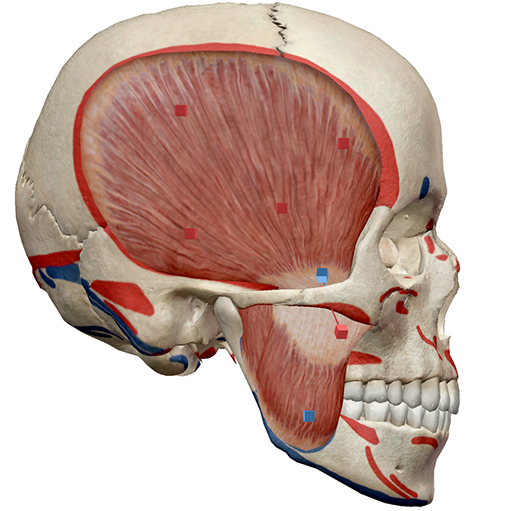 Image from Muscle Premium.
Image from Muscle Premium.
|
|
Origin |
Insertion |
Action |
Innervation |
|
Deep masseter |
Zygomatic arch |
Mandible |
Raises mandible against the maxillae with great force |
Trigeminal nerve (V), mandibular branch (V3) |
|
Temporalis |
Temporal fossa and temporal fascia |
Coronoid process and anterior ramus of the mandible |
Elevates and retracts the mandible against the maxillae with great force |
Trigeminal nerve (V), mandibular branch |
Mandible elevation involves both muscles working to bring the mandible back up toward the maxillae. Remember, when you chew, it's only your jaw that moves; the maxillae remain fixed to the skull. The mandible is the only free-moving bone in the skull.
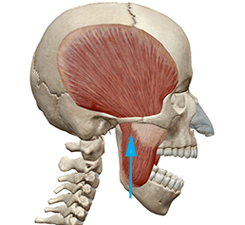
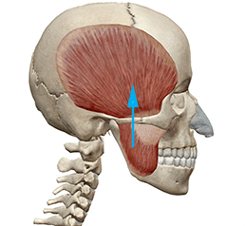 Check out these muscle movements and more in Muscle Premium!
Check out these muscle movements and more in Muscle Premium!
Superficial Muscles of Mastication
The superficial muscles group is comprised of three muscles: the medial pterygoid, lateral pterygoid (superior and inferior heads), and superficial masseter.
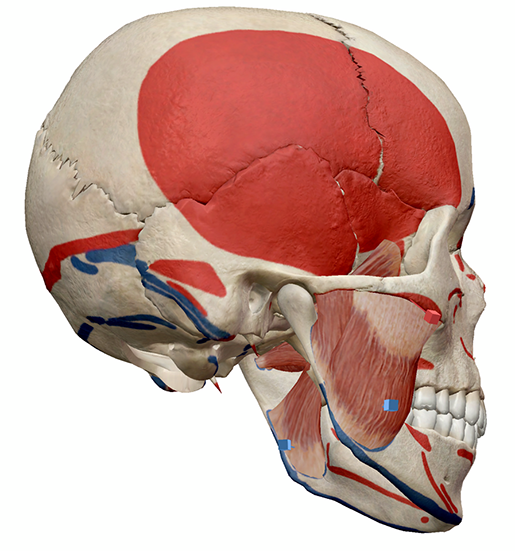 Image from Muscle Premium.
Image from Muscle Premium.
The medial pterygoid and superficial masseter are pretty straightforward, but the lateral pterygoid is an interesting little thing. It is one muscle but originates in two different locations. There are other muscles in the body that have two different origins, such as the biceps brachii, but the lateral pterygoid is the only one in the head region.
|
|
Origin |
Insertion |
Action |
Innervation |
|
Superficial masseter |
Zygomatic bone |
Ramus of the mandible |
Raises the mandible against the maxillae with great force |
Trigeminal nerve (V), mandibular branch (V3) |
|
Medial pterygoid |
Lateral pterygoid plate and the pyramidal process of the palatine |
Ramus and angle of the mandible via a strong tendinous lamina |
Assists the lateral pterygoid; draws the mandible forward |
Trigeminal nerve (V), mandibular branch |
|
Lateral pterygoid |
Two heads: the superior from the sphenoid and infratemporal crest; the inferior from the lateral pterygoid plate |
Condyle of the mandible and front margin of the articular disk of the temporomandibular articulation |
Draws the mandibular condyle and articular disc forward |
Trigeminal nerve (V), mandibular branch |
Have you ever thrust your jaw out so your bottom teeth stick out in order to look like a bulldog? It's a face my youngest niece loves to make. Besides being hilarious on her little face, it's also a muscle action called mandible protraction, and all the superficial muscles of mastication are involved.
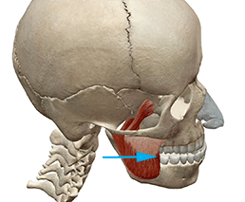
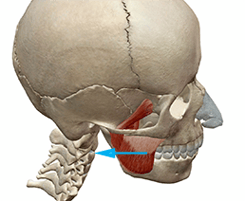
Check out these muscle movements and more in Muscle Premium!
Protraction (on the left) is the act of protrusion, or extending beyond the normal position. The opposing action is called retraction (on the right).
Temporomandibular Joint Dysfunction
Fun fact: I have TMJ. Well, we all have TMJ—the temporomandibular joint, that is. TMJ (and TMD, interchangeably) has also become an umbrella term for jaw and muscle pain.
When I was in high school, I used to go through a pack of gum every day. I would chew and chew and chew and chew until, finally, my mastication muscles gave up the ghost and began exhibiting some pretty awful pain, followed by extremely limited jaw movement (I couldn't open my mouth properly for a while). Soon after, the articular disc floated out from between the fossa and condyle, causing my jaw joint to "click." While the muscle pain has long since abated, the clicking and popping of my jaw continues today.
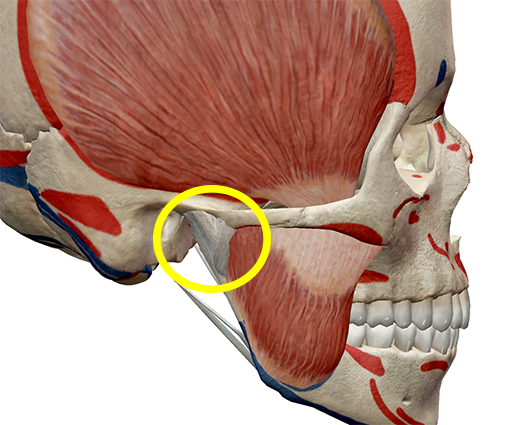 Image captured from Muscle Premium.
Image captured from Muscle Premium.
Temporomandibular joint dysfunction is the term used to describe pain arising from the temporomandibular joint and mastication muscles. It's an incredibly common ailment—anywhere from 20% to 30% of the population has it—and not very well understood, because not one thing causes it. TMD can be categorized by symptom, cause, and/or how long one has had it, and it is treated in a variety of ways, ranging from relaxation techniques to surgery (in extreme cases).
My best advice is to ease up on excessive gum chewing.
Be sure to subscribe to the Visible Body Blog for more anatomy awesomeness!
Are you an instructor? We have award-winning 3D products and resources for your anatomy and physiology course! Learn more here.



